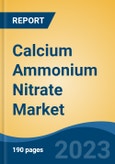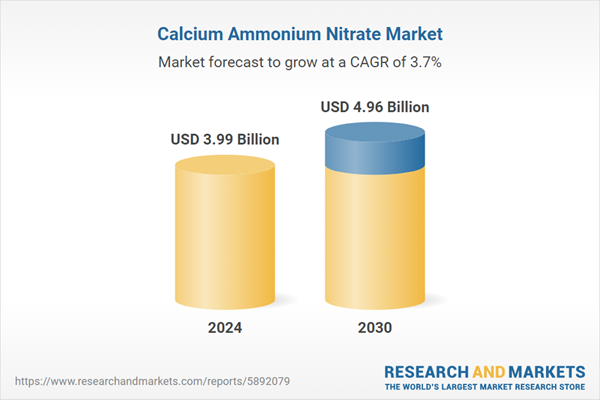Free Webex Call
The Calcium Ammonium Nitrate Market was valued at USD 3.99 Billion in 2024, and is expected to reach USD 4.96 Billion by 2030, rising at a CAGR of 3.70%. Calcium ammonium nitrate, also known as nitro limestone and nitro chalk, is a fertilizer widely used across the globe. It is produced by mixing powdered limestone in ammonium nitrate, resulting in a neutral mixture with the ability to neutralize acidic soil. This essential source of nitrogen for plant growth is quickly absorbed by plant roots during the fruiting stage, making it highly valued by farmers worldwide. Speak directly to the analyst to clarify any post sales queries you may have.
10% Free customizationThis report comes with 10% free customization, enabling you to add data that meets your specific business needs.
Moreover, the presence of calcium not only improves soil health but also ensures long-term benefits. The fertilizer grade of calcium ammonium nitrate typically contains approximately 8% calcium and 21% to 27% nitrogen, making it suitable for enhancing root and soil health. Interestingly, calcium ammonium nitrate serves as a viable alternative in countries where ammonium nitrate is banned. Additionally, due to its hygroscopic nature, it has the ability to retain water molecules even at room temperature, further contributing to its effectiveness.
Key Market Drivers
Growing Demand of Calcium Ammonium Nitrate in Agriculture Industry
The agriculture industry serves as the primary growth engine for the global calcium ammonium nitrate (CAN) market, driven by the increasing need for high-efficiency fertilizers, sustainable farming practices, and food security across both developed and emerging economies. The rising importance of CAN as a nitrogen-based fertilizer coupled with its superior agronomic benefits continues to fuel its widespread adoption and market expansion. Asia currently holds the largest share of the global population, demographic projections indicate that Africa is poised for a significant surge in population growth, with its share expected to approach 40% of the global total by the end of the century.The ongoing rise in the global population, especially in Asia and Africa, has placed tremendous pressure on the agriculture sector to increase food production. Farmers are under constant demand to improve crop yields within limited arable land. CAN, known for its rapid nitrogen availability and balanced nutrient composition (including calcium), is increasingly favored to support higher productivity, particularly in nitrogen-depleted soils.
This direct link between agricultural output and CAN application is significantly driving market growth. Modern agricultural practices are increasingly moving away from traditional fertilizers like urea due to their one-dimensional nutrient profiles and environmental impact. Calcium ammonium nitrate offers a more balanced nutrient solution, supplying both fast-acting nitrate nitrogen and stabilizing ammonium nitrogen along with calcium. This combination improves nutrient uptake efficiency and promotes robust plant growth, making CAN a preferred choice among progressive farmers and large-scale agribusinesses.
Governments across multiple agricultural economies are promoting the use of advanced fertilizers like CAN through subsidies, training programs, and regulatory reforms. For example, European countries have been encouraging nitrogen fertilizers with lower environmental footprints, while nations like India include CAN under essential Agro-inputs within government-supported procurement schemes.
Such initiatives have increased both the accessibility and affordability of CAN, boosting its demand in the agriculture sector. CAN holds several agronomic advantages over traditional nitrogenous fertilizers such as urea or ammonium sulfate. It has low volatilization losses, does not acidify the soil to the same extent, and provides a dual nutrient impact (calcium and nitrogen), leading to improved crop quality and longer shelf life. These characteristics make it suitable for high-value crops like fruits, vegetables, and plantation crops further strengthening its position in agricultural markets.
Key Market Challenges
Growing Preference for Organic Fertilizers
Calcium Ammonium Nitrate, known for its hygroscopic properties, is primarily utilized as an inorganic fertilizer. However, the excessive use of such fertilizers can lead to environmental issues such as soil, water, and air pollution due to nutrient leaching and the accumulation of toxic chemicals. In response to these concerns, governments have launched various investments and initiatives to promote the use of organic or biofertilizers. For instance, in March 2022, the United States Department of Agriculture announced plans to invest a substantial amount of US$250 million in promoting the production of sustainable and organic fertilizers nationwide. This initiative aims to support the transition towards environmentally friendly agricultural practices.Key Market Trends
Adoption of Advanced Farming Technologies
Precision agriculture, the cutting-edge approach to farming, involves the strategic use of advanced tools such as global positioning systems (GPS), sensors, and data analytics. These tools empower farmers to monitor and manage agricultural practices with unrivaled precision. By precisely targeting nutrient application, including the optimized use of fertilizers like Calcium Ammonium Nitrate, the waste can be minimized, while crop efficiency is vastly improved.To further enhance nutrient management, controlled-release fertilizers are specifically designed to gradually release nutrients over an extended period. This remarkable feature allows these fertilizers to align perfectly with the specific needs of crops. As a result, controlled-release fertilizers not only enhance nutrient uptake but also reduce leaching, minimizing the overall environmental impact. In the realm of sustainable nutrient management, Calcium Ammonium Nitrate can be formulated as a controlled-release fertilizer, making it compatible with advanced farming technologies.
Key Market Players
- Barium & Chemicals, Inc.
- Yara International ASA
- EuroChem Group
- Achema AB
- Origin Fertilizers Limited
- Fertinagro India Pvt. Ltd
- Agrico Canada
- San Corporation
- Helm AG
- Pakarab Fertilizers Limited
Report Scope:
In this report, the Global Calcium Ammonium Nitrate Market has been segmented into the following categories, in addition to the industry trends which have also been detailed below:Calcium Ammonium Nitrate Market, By Application:
- Fertilizers
- Explosives
- Others
Calcium Ammonium Nitrate Market, By Region:
- North America
- United States
- Canada
- Mexico
- Europe
- France
- United Kingdom
- Italy
- Germany
- Spain
- Asia-Pacific
- China
- India
- Japan
- Australia
- South Korea
- South America
- Brazil
- Argentina
- Colombia
- Middle East & Africa
- South Africa
- Saudi Arabia
- UAE
Competitive Landscape
Company Profiles: Detailed analysis of the major companies present in the Global Calcium Ammonium Nitrate Market.Available Customizations:
With the given market data, the publisher offers customizations according to a company's specific needs. The following customization options are available for the report.Company Information
- Detailed analysis and profiling of additional market players (up to five).
Table of Contents
1. Product Overview
2. Research Methodology
3. Executive Summary
6. Calcium Ammonium Nitrate Market Outlook
7. North America Calcium Ammonium Nitrate Market Outlook
8. Europe Calcium Ammonium Nitrate Market Outlook
9. Asia-Pacific Calcium Ammonium Nitrate Market Outlook
10. South America Calcium Ammonium Nitrate Market Outlook
11. Middle East and Africa Calcium Ammonium Nitrate Market Outlook
12. Market Dynamics
13. Market Trends & Developments
18. Competitive Landscape
Companies Mentioned
- Barium & Chemicals, Inc.
- Yara International ASA
- EuroChem Group
- Achema AB
- Origin Fertilizers Limited
- Fertinagro India Pvt. Ltd
- Agrico Canada
- San Corporation
- Helm AG
- Pakarab Fertilizers Limited
Table Information
| Report Attribute | Details |
|---|---|
| No. of Pages | 180 |
| Published | August 2025 |
| Forecast Period | 2024 - 2030 |
| Estimated Market Value ( USD | $ 3.99 Billion |
| Forecasted Market Value ( USD | $ 4.96 Billion |
| Compound Annual Growth Rate | 3.7% |
| Regions Covered | Global |
| No. of Companies Mentioned | 10 |









